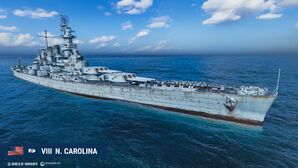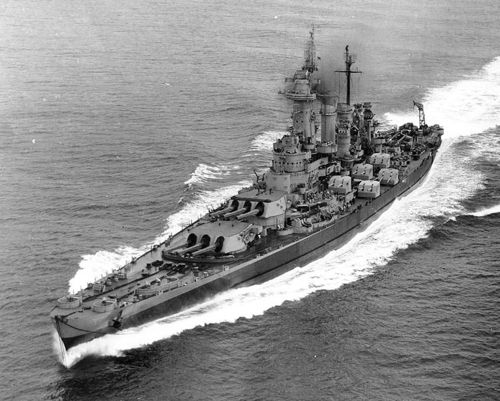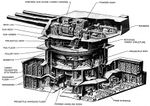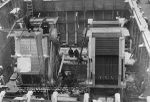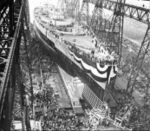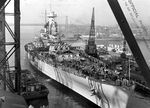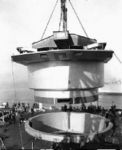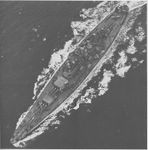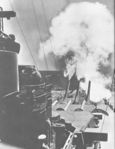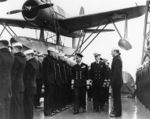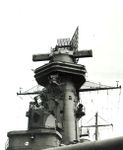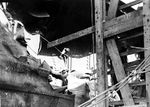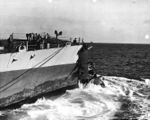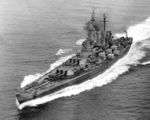North Carolina
| Revision as of 17:02, 29 June 2016 | Revision as of 07:15, 16 January 2020 added info about halloween perma camo | |||
28 intermediate revisions by 19 users not shown | ||||
| Line 3: | Line 3: | |||
| |Anno=<!-- you can write below short description for the ship. it will replace default once. --> | |Anno=<!-- you can write below short description for the ship. it will replace default once. --> | |||
| + | The first U.S. battleship of the new generation. The key advantage over her predecessors of this type was significantly increased speed. In contrast to preceding ships of the same type, she featured a thinner armor belt, but had very solid horizontal armor protection and a superior AA armament including numerous dual-purpose artillery.<br><br>USS ''North Carolina'' is now preserved as a [//www.battleshipnc.com/ military museum ship] in Wilmington, North Carolina.<br><br>{{Model3DViewer|0b2da4c67ab84ac1b78429e0fd86b758}} | |||
| |Performance=<!-- write text about performance in battles below --> | |Performance=<!-- write text about performance in battles below --> | |||
| ? | The biggest transition in American battleship | + | The biggest transition in American battleship game play, ''North Carolina'' is the first fast battleship of the American line. She is a welcome change of pace for players used to the 21 knot top speed of ''[[New York]], [[New Mexico]]'', and ''[[Colorado]]'', and is a radical departure from the pudgy appearance and mediocre firing range of her dreadnought predecessors. | |
| ? | | | + | ''North Carolina'' boasts speed, protection, armament, and handling that represent improvements in ship design made over the span of a 15-year gap in American battleship construction that began in the mid-1920's. Her fully upgraded top speed of 28 knots is immediately noticeable, and while other Tier VIII battleships like ''[[Bismarck]], [[Tirpitz]]'', and ''[[Amagi]]'' can still outrun her, the gap in speed is limited to a only few knots. ''North Carolina'' is more than capable of keeping up with her team and using her excellent range to begin punishing enemy units while they close. | |
| + | ||||
| + | ''North Carolina'' can fire at very long ranges fully upgraded, which is a double-edged sword. ''If'' the super-heavy AP shells hit at such ranges, they are legitimate plunging fire penetrations and will pierce most citadel decks. However her dispersion is irritating and the muzzle velocities of her 16-inch, 45 caliber guns are slower than the 50 caliber guns found on ''[[Iowa]]'' and ''[[Montana]]''. Those deadly high arc shells seemingly take forever to return to earth at ranges past 13-14 km, meaning that captains must use additional lead when firing at far off targets. Frustratingly, she cannot equip [[Ship:Upgrades#Tier_V.2B_Equipment_.28Slot_2.29|Aiming Systems Modification 1]] to improve her dispersion, either. All-and-all, 23+ kilometer bombing is not a good use of salvos and match time unless the enemy is camping in place. | |||
| + | ||||
| + | Still, there are some nice trade-offs. Unlike many ships, her stock configuration is relatively solid, and when fully upgraded her anti-aircraft suite is brutally punishing to enemy planes. When fully-rigged for stealth — via [[Ship:Upgrades#Tier_VIII.2B_Equipment_.28Slot_6.29|Concealment Systems Modification 1]] and the Concealment Expert commander skill — her surface detection range drops to a positively ludicrous 12.1 km. This frequently allows ''North Carolina'' to maneuver unseen and strike at unsuspecting cruisers and battleships from an angle they did not anticipate. It also allows her to cease fire and escape when necessary; she is very easy to citadel while broadside to enemy ships (even cruisers!), so care must be taken when turning around under fire. She has the worst torpedo protection out of all Tier VIII battleships; captains must be very cautious about putting ''North Carolina'' into a position where enemy destroyers will focus torpedoes on her. | |||
| + | ||||
| + | With careful positioning and heads-up play, ''North Carolina'' is an solid all-around Tier VIII battleship. | |||
| + | ||||
| + | {{VideoYT|rb298JtNoK8|320}} | |||
| |Pros=<!-- write list of positive points below. use * as in ordinary wiki-list. --> | |Pros=<!-- write list of positive points below. use * as in ordinary wiki-list. --> | |||
| ? | * | + | * Handles very differently from her predecessors. | |
| ? | * Highest range of any | + | * Highest range of any Tier VIII battleship. | |
| ? | * Unrivaled AA suite at her tier | + | * Unrivaled AA suite at her tier. | |
| * Very durable when angled. | * Very durable when angled. | |||
| ? | * Decently fast at nearly 28 | + | * Decently fast at nearly 28 knots. | |
| ? | * 16 inch guns fire the same | + | * 16-inch guns fire the same super-heavy shells as ''[[Iowa]]'' and ''[[Montana]]'', so the shell penetration and damage are devastating with good hits. | |
| ? | + | |||
| |Cons=<!-- write list of negative points below. use * as in ordinary wiki-list. --> | |Cons=<!-- write list of negative points below. use * as in ordinary wiki-list. --> | |||
| ? | * Rudder shift is | + | * Rudder shift is fairly slow. | |
| ? | * | + | * Below average armor piercing shell velocity. | |
| ? | * Large citadel and not as well-armored as Colorado | + | * Dispersion can be unfriendly at times, and she can't mount [[Ship:Upgrades#Tier_V.2B_Equipment_.28Slot_2.29|Aiming Systems Modification 1]] to improve it. | |
| ? | * Small volume of secondaries compared to other | + | * Large citadel and not as well-armored as ''[[Colorado]]''; flashing her broadside to enemy battleships is suicidal. | |
| ? | * Extremely poor torpedo defense | + | * Small volume of secondaries compared to other Tier VIII battleships. | |
| ? | + | * Extremely poor torpedo defense at only 19% (compared to ''[[Amagi]]''’s 43% and ''[[Bismarck]]''’s 22%). | ||
| ? | * | + | ||
| + | |Research=<!-- write text about priority sequence of research below --> | |||
| + | Experience gains should be allocated to Hull (B) first, the Engine upgrade module next, and lastly to the Fire Control System buff to ''North Carolina''’s range. | |||
| + | ||||
| + | |OptimalConfiguration=<!-- write some general text about selection of optimal configuration below (optional)--> | |||
| + | ||||
| + | |Upgrades=<!-- write text about best upgrades below --> | |||
| + | ||||
| + | '''Slot 1''' is most commonly filled with {{Main Armaments Modification 1}}, though {{Auxiliary Armaments Modification 1}} is a popular pick for captains who go for a full AA build with other upgrades and commander skills. | |||
| + | ||||
| + | '''Slot 2''' has one choice for battleships - {{Damage Control System Modification 1}}. This will reduce chances of fire and flood. | |||
| + | ||||
| + | '''Slot 3''' offers several options. {{AA Guns Modification 1}} will boost AA strength, while {{Secondary Battery Modification 2}} will boost the range and accuracy of secondaries instead. {{Artillery Plotting Room Modification 1}} will increase range and give secondaries a slight boost in range and accuracy, but may be a weaker choice than the other two. | |||
| + | ||||
| + | '''Slot 4''' {{Steering Gears Modification 2}} is recommended and will reduce rudder shift time. Captains with fire problems could also consider {{Damage Control System Modification 2}}, reducing the amount of time on fire and conserving hit points. | |||
| + | ||||
| + | '''Slot 5''' Maximizing stealth is never a bad choice. With the Concealment Expert commander skill, {{Concealment System Modification 1}}, and appropriate camouflage, this ship can choose when to engage the enemy. | |||
| + | ||||
| + | |CommanderSkills=<!-- write text about best set of Commander Skills below --> | |||
| + | ''North Carolina'' is often built either for anti-aircraft, or for survivability. The captain skills reflect this, either focusing on survival skills like ''Fire Prevention,'' ''High Alert,'' and ''Basics of Surivability,'' or skills such as ''Advanced Firing Training'' and ''Manual Fire Control for AA Armament.'' ''Concealment Expert'' is highly recommended with all builds. | |||
| + | ||||
| + | {{Commander Skills 2 | |||
| + | <!-- This version enables a '0' rating. Use it for skills that have no effect (e.g. Improved Engines on a non-CV) or are detrimental to the ship. They should mirror what appears in the game client. --> | |||
| + | | rating11 = 2 <!-- Priority Target --> | |||
| + | | rating12 = 1 <!-- Preventive Maint --> | |||
| + | | rating13 = 1 <!-- Expert Loader --> | |||
| + | | rating14 = 0 <!-- Air Supremacy --> | |||
| + | | rating15 = 2 <!-- Direction Center for Fighters --> | |||
| + | | rating16 = 0 <!-- Improved Engine Boost --> | |||
| + | | rating17 = 1 <!-- Incoming Fire Alert --> | |||
| + | | rating18 = 0 <!-- Last Gasp --> | |||
| + | ||||
| + | | rating21 = 2 <!-- High Alert --> | |||
| + | | rating22 = 1 <!-- Jack of All Trades --> | |||
| + | | rating23 = 3 <!-- Expert Marksman --> | |||
| + | | rating24 = 0 <!-- Torpedo Acceleration --> | |||
| + | | rating25 = 0 <!-- Smoke Screen Expert --> | |||
| + | | rating26 = 0 <!-- Improved Engines --> | |||
| + | | rating27 = 2 <!-- Adrenaline Rush --> | |||
| + | | rating28 = <!-- Last Stand --> | |||
| + | ||||
| + | | rating31 = 2 <!-- Basics of Survivability --> | |||
| + | | rating32 = <!-- Survivability Expert--> | |||
| + | | rating33 = 0 <!-- Torpedo Armament Expertise--> | |||
| + | | rating34 = 0 <!-- Aircraft Armor --> | |||
| + | | rating35 = 3 <!-- Basic Firing Training --> | |||
| + | | rating36 = 3 <!-- Superintendent --> | |||
| + | | rating37 = 1 <!-- Demolition Expert --> | |||
| + | | rating38 = 1 <!-- Vigilance --> | |||
| + | ||||
| + | | rating41 = <!-- Manual Fire Control for Secondary Armament --> | |||
| + | | rating42 = 3 <!-- Fire Prevention --> | |||
| + | | rating43 = <!-- Inertia Fuse for HE Shells --> | |||
| + | | rating44 = 0 <!-- Sight Stabilization --> | |||
| + | | rating45 = 3 <!-- Advanced Firing Training --> | |||
| + | | rating46 = <!-- Massive AA Fire --> | |||
| + | | rating47 = <!-- Radio Position Finding --> | |||
| + | | rating48 = 3 <!-- Concealment Expert --> | |||
| + | }} | |||
| + | ||||
| + | |Consumables=<!-- write text about selection of Consumables below --> | |||
| + | ''{{#var:ship_name}}'' can equip the following consumables: | |||
| + | * '''Slot 1:''' {{Damage Control Party}} | |||
| + | * '''Slot 2:''' {{Repair Party}} | |||
| + | * '''Slot 3:''' {{Spotting Aircraft}} '''or''' {{Catapult Fighter}} | |||
| + | ||||
| + | |Camouflage=<!-- write text about useful camouflage below --> | |||
| + | [[Ship:Camouflage#Standard Camouflage|Type 1, 2, or 5 camouflage]] can be equipped for credits; Types 2 or 5 are recommended at a minimum to reduce the accuracy of incoming shells. | |||
| + | ||||
| + | Players who wish to spend doubloons can equip ''North Carolina'' with [[Ship:Camouflage#Permanent_Camouflage|Type 18 camouflage]] that lowers her detection radius, reduces the accuracy of incoming shells, reduces her repair costs, and increases the amount of experience she earns. | |||
| + | ||||
| + | North Carolina also has an alternate premium camouflage called "Leviathan", in which she appears as she does during the Halloween scenario "Terror of the Deep". | |||
| + | ||||
| + | |Signals=<!-- write text about best set of signals below --> | |||
| + | As a battleship, ''North Carolina'' benefits greatly from flags that boost her survivability, such as ''India Delta,'' ''November Foxtrot,'' and ''India Yankee.'' | |||
| + | ||||
| + | {{Signal Flags | |||
| + | | Hotel Yankee = 1 | |||
| + | | Juliet Charlie = 1 | |||
| + | | November Foxtrot = 1 | |||
| + | | Zulu = | |||
| + | | Juliet Yankee Bissotwo = 1 | |||
| + | | India Delta = 3 | |||
| + | ||||
| + | | India Yankee = 2 | |||
| + | | November Echo Setteseven = 2 | |||
| + | | Zulu Hotel = 1 | |||
| + | | India Bravo Terrathree = | |||
| + | | Sierra Mike = 3 | |||
| + | | Victor Lima = | |||
| + | ||||
| + | | Mike Yankee Soxisix = 1 | |||
| + | | Papa Papa = | |||
| + | | India X-Ray = | |||
| + | | Equal Speed Charlie London = 3 | |||
| + | | Juliet Whiskey Unaone = | |||
| + | | Dragon Flag = 1 | |||
| + | }} | |||
| |Gallery=<!-- write below list of files with description (if necessary) separated with | --><gallery> | |Gallery=<!-- write below list of files with description (if necessary) separated with | --><gallery> | |||
| ? | </gallery>|History=<!-- write text below --> | + | </gallery> | |
| ? | The North Carolina class was a class of two fast battleships, North Carolina and Washington, built for the United States Navy in the late 1930s and early 1940s. The navy was originally uncertain whether the ships should be fast enough to counter the Japanese | + | ||
| + | |History=<!-- write text below --> | |||
| + | <div class="thumb tright"> | |||
| + | {{AnnoWiki|content= | |||
| + | <h3>Construction</h3> | |||
| + | :New York Naval Yard; New York, United States | |||
| + | :Laid down: 21 October 1937 | |||
| + | :Launched: 13 June 1940 | |||
| + | :Commissioned: 9 April 1941 | |||
| + | ----- | |||
| + | ====Specifications==== | |||
| + | :37,484 tons displacement, standard | |||
| + | :46,700 tons displacement, full load | |||
| + | :222.12m length | |||
| + | :33.01m beam | |||
| + | :10.04m draft | |||
| + | ----- | |||
| + | ====Machinery==== | |||
| + | :8 boilers, 4 turbines | |||
| + | ----- | |||
| + | ====Performance==== | |||
| + | :28 knots at 121,000 shaft horsepower | |||
| + | :17,450nm at 15 knots | |||
| + | ----- | |||
| + | ====Armor==== | |||
| + | :Main belt: 305mm | |||
| + | :Decks: 127mm | |||
| + | :Bulkheads: 280mm | |||
| + | :Barbettes and Turrets: 406mm barbette, 406mm face,<Br> 250mm side, 300mm rear, 178mm roof | |||
| + | :Conning tower: 406mm | |||
| + | ----- | |||
| + | ====Armament==== | |||
| + | =====Main===== | |||
| + | :Nine (3x3) 406mm guns | |||
| + | =====Secondary===== | |||
| + | :Twenty (10x2) 127mm guns | |||
| + | =====Anti-Aircraft===== | |||
| + | :Sixteen (4x4) 28mm guns | |||
| + | :Twelve (12x1) 12.7mm guns | |||
| + | ----- | |||
| + | ====Aircraft==== | |||
| + | :Three Vought OS2U Kingfisher floatplanes, two catapults | |||
| + | }} | |||
| + | </div> | |||
| + | <div class="thumb tright">{{VideoYT|Q5f7mgQeHEI|320}}</div> | |||
| + | [[File:USS Washington (BB-56) in Puget Sound, 10 September 1945.jpeg|500px|link=]] | |||
| + | ===History=== | |||
| + | ====Design==== | |||
| + | The North Carolina class was a class of two fast battleships, ''North Carolina'' and ''Washington'', built for the United States Navy in the late 1930s and early 1940s. The navy was originally uncertain whether the ships should be fast enough to counter the Japanese ''[[Kongo]]'' class, which was believed by the United States to be capable of 26 knots (30 mph; 48 km/h), or should sacrifice speed for additional firepower and armor. The Second London Naval Treaty's requirement that all capital ships have a standard displacement of under 35,000 long tons (35,560 metric tons) prevented the desired objectives from being fully realized within its limits, and the navy considered over fifty designs before one was chosen. | |||
| Towards the end of this lengthy design period the General Board of the United States Navy declared its preference for a battleship with a speed of 30 knots (35 mph; 56 km/h), faster than any in US service or under construction, with a main battery of nine 14-inch (356 mm)/50 caliber Mark B guns. The board believed that such ships could fulfill a multitude of roles, as they would have enough protection to be put into a battle line while also having enough speed to escort aircraft carriers or engage in commerce raiding. However, the acting Secretary of the Navy authorized a modified version of a different design, which in its original form had been rejected by the General Board. This called for a 27-knot (31 mph; 50 km/h) ship with twelve 14-inch rifles in quadruple turrets and protection against guns of the same caliber. In a major departure from traditional American design practices, this design accepted lower speed and protection in exchange for maximum firepower. After construction had begun, the United States became concerned over Japan's refusal to commit to the caliber limit of the Second London Naval Treaty, so they invoked the "escalator clause" of that pact and increased the class' main armament to nine 16-inch (406 mm)/45 Mark 6 caliber guns from the original twelve 14-inch guns. | Towards the end of this lengthy design period the General Board of the United States Navy declared its preference for a battleship with a speed of 30 knots (35 mph; 56 km/h), faster than any in US service or under construction, with a main battery of nine 14-inch (356 mm)/50 caliber Mark B guns. The board believed that such ships could fulfill a multitude of roles, as they would have enough protection to be put into a battle line while also having enough speed to escort aircraft carriers or engage in commerce raiding. However, the acting Secretary of the Navy authorized a modified version of a different design, which in its original form had been rejected by the General Board. This called for a 27-knot (31 mph; 50 km/h) ship with twelve 14-inch rifles in quadruple turrets and protection against guns of the same caliber. In a major departure from traditional American design practices, this design accepted lower speed and protection in exchange for maximum firepower. After construction had begun, the United States became concerned over Japan's refusal to commit to the caliber limit of the Second London Naval Treaty, so they invoked the "escalator clause" of that pact and increased the class' main armament to nine 16-inch (406 mm)/45 Mark 6 caliber guns from the original twelve 14-inch guns. | |||
| ? | Both North Carolina and Washington saw extensive service during the Second World War in a variety of roles, primarily in the Pacific theater where they escorted fast carrier task forces and conducted shore bombardments. North Carolina shot down between seven and fourteen Japanese aircraft in the Battle of the Eastern Solomons, and later sustained a torpedo hit from | + | ====Service==== | |
| + | Both ''North Carolina'' and ''Washington'' saw extensive service during the Second World War in a variety of roles, primarily in the Pacific theater where they escorted fast carrier task forces and conducted shore bombardments. ''North Carolina'' shot down between seven and fourteen Japanese aircraft in the Battle of the Eastern Solomons, and later sustained a torpedo hit from Japanese submarine ''I-15''. During the naval battle of Guadalcanal —which was a chaotic night engagement — ''Washington''’s radar-directed main batteries fatally damaged the Japanese battleship ''Kirishima'' and caused her to sink next day. In February 1944, ''Washington'' crushed her bow in a collision with battleship ''Indiana''. Following repairs, ''Washington'' rejoined her sister for the Battle of the Philippine Sea. | |||
| ? | ==Historical | + | After the end of the war, both ships took part in Operation Magic Carpet, the withdrawal of American military personnel from overseas deployments. The vessels were laid up in the reserve fleet until the early 1960s, when ''North Carolina'' was sold to her home state as a museum ship, and ''Washington'' was broken up for scrap. | |
| ? | North Carolina's | + | ||
| ? | Actual speed was 28 knots in 1941 and 26.8 knots in 1945. | + | ==Historical Inaccuracies== | |
| + | * ''North Carolina'' has a unique permanent camouflage in that upgrading to Hull (B) will change the ship's camouflage pattern. Measure 12 is tied to Hull (A) while Measure 32 is tied to Hull (B). | |||
| + | * The Measure 12 camouflage was used by ''North Carolina'' in 1942. During this time she was armed with five quad 1.1-inch (28 mm) cannons. Hull (A) represents ''North Carolina'' after her November 1942 refit, when she was re-equipped with ten quad 40 mm Bofors. By this time she had been repainted with Measure 21 camouflage, which is overall Navy Blue with dark Deck Blue decks. This camouflage scheme should be on Hull (A) and it is currently missing. | |||
| + | * ''North Carolina''’s original anti-aircraft complement of four quad 1.1"/75 (28 mm) cannons and twelve .50 caliber (12.7 mm) M2 Browning machine guns is not represented. | |||
| + | * Actual propulsion is 121,000 hp. There was no 100,000 hp downgrade. | |||
| + | * Actual speed was 28 knots in 1941 and 26.8 knots in 1945, due to increasing number of AA gun mounts and electronics as the World War 2 progressed. | |||
| + | * The Measure 22 camouflage applied to ''North Carolina'' from 1945-1946 is missing. | |||
| |HistoricalGallery=<!-- write below list of files with description (if necessary) separated with | --><gallery> | |HistoricalGallery=<!-- write below list of files with description (if necessary) separated with | --><gallery> | |||
| ? | ||||
| ? | ||||
| ? | ||||
| File:North Carolina class scheme A.jpeg|The 32,250-long-ton (32,770 t) design "A" was one of the first proposals. Unlike "B" and "C", it was far below the treaty-mandated limit of 35,000 long tons (36,000 t). It would have carried nine 14-inch (356 mm) guns in its main battery; although all of the turrets were forward of the superstructure, the guns could still fire forward provided that they were elevated to 4.5 degrees or more. The secondary battery planned was twelve 5-inch (130 mm) were unusually arranged in triple mounts. | File:North Carolina class scheme A.jpeg|The 32,250-long-ton (32,770 t) design "A" was one of the first proposals. Unlike "B" and "C", it was far below the treaty-mandated limit of 35,000 long tons (36,000 t). It would have carried nine 14-inch (356 mm) guns in its main battery; although all of the turrets were forward of the superstructure, the guns could still fire forward provided that they were elevated to 4.5 degrees or more. The secondary battery planned was twelve 5-inch (130 mm) were unusually arranged in triple mounts. | |||
| File:North Carolina class scheme F.jpeg|"F" was an attempt to create a viable combination of an aircraft carrier and a battleship. With regards to the treaty limits, the design had an extremely comfortable margin with a standard displacement of 31,750 long tons (32,260 t; 35,560 short tons). Three catapults were mounted on the bow, while a hangar located under that would contain ten bombers with wings folded. Two non-superfiring turrets would be mounted aft, both holding four 14-in guns. | File:North Carolina class scheme F.jpeg|"F" was an attempt to create a viable combination of an aircraft carrier and a battleship. With regards to the treaty limits, the design had an extremely comfortable margin with a standard displacement of 31,750 long tons (32,260 t; 35,560 short tons). Three catapults were mounted on the bow, while a hangar located under that would contain ten bombers with wings folded. Two non-superfiring turrets would be mounted aft, both holding four 14-in guns. | |||
| File:North Carolina class scheme VII.jpeg|"VII" harked back to the days of the slow battleships; with a top speed of 22 knots (25 mph; 41 km/h), it would have been only 1 knot (1.2 mph; 1.9 km/h) faster than the old ""standard" battleships. The weight gained from reducing the speed was added back in firepower and protection: "VII" would have had twelve 14-inch/50 caliber guns in four triple turrets and an immune zone against its own 14-inch gun between 21,400 and 30,000 yards (12.2 and 17.0 mi; 19.6 and 27.4 km). | File:North Carolina class scheme VII.jpeg|"VII" harked back to the days of the slow battleships; with a top speed of 22 knots (25 mph; 41 km/h), it would have been only 1 knot (1.2 mph; 1.9 km/h) faster than the old ""standard" battleships. The weight gained from reducing the speed was added back in firepower and protection: "VII" would have had twelve 14-inch/50 caliber guns in four triple turrets and an immune zone against its own 14-inch gun between 21,400 and 30,000 yards (12.2 and 17.0 mi; 19.6 and 27.4 km). | |||
| ? | File:North Carolina class scheme XVI.jpeg|"XVI" was one of the final proposals; after "XVI-C" was rejected, a modified version of this design was chosen for the North Carolinas. There were a few major differences between this and the final plan. For example, all exhaust was eventually trunked into two funnels as opposed to one, and the 5-in/38 caliber secondary battery was composed of all dual-mounted guns (no single). | + | File:North Carolina class scheme XVI.jpeg|"XVI" was one of the final proposals; after "XVI-C" was rejected, a modified version of this design was chosen for the ''North Carolinas''. There were a few major differences between this and the final plan. For example, all exhaust was eventually trunked into two funnels as opposed to one, and the 5-in/38 caliber secondary battery was composed of all dual-mounted guns (no single). | |
| ? | File:16in Gun Turret.jpeg|A cut-away diagram of the 16-inch turrets on board the North Carolina class | + | File:16in Gun Turret.jpeg|A cut-away diagram of the 16-inch turrets on board the ''North Carolina'' class. | |
| ? | + | File:No.2 machinery space of USS North Carolina (BB-55) during construction.jpeg|USS ''North Carolina''’s (BB-55) No. 2 machinery space under construction, seen from the port side of the ship on 16 January 1939; the No. 4 boiler has just been installed. | ||
| ? | File:No.2 machinery space of USS North Carolina (BB-55) during construction.jpeg|North Carolina' | + | File:USS Washington (BB-56) launching ceremony, 1 June 1940.jpeg|The launch of USS ''Washington'' (BB-56), 1 June 1940. | |
| ? | File:USS Washington (BB-56) turret installation.jpeg|One of | + | File:USS North Carolina Fit out NARA 1941-04-17.jpeg|''North Carolina'' fitting out, April 1941. | |
| ? | File:USS North Carolina | + | File:USS Washington (BB-56) turret installation.jpeg|One of ''Washington''’s main gun turrets is installed upon the ship; note how thick the barbette is, ranging from 11.5 to 16 inches (290–410 mm). | |
| ? | File: | + | File:USS North Carolina overhead.jpeg|''North Carolina'' seen from the air on 17 April 1942. | |
| ? | + | File:USS North Carolina fires over bow.jpeg|''North Carolina'' fires a three-gun salvo from her number one turret. | ||
| ? | + | File:King George VI inspects the crew of USS Washington (BB-56), June 1942.jpeg|King George VI of the United Kingdom (left column, walking towards camera) on board ''Washington'', 7 June 1942. An OS2U Kingfisher is in the background. | ||
| ? | File:King George VI inspects the crew of USS Washington (BB-56), June 1942.jpeg|King George VI of the United Kingdom (left column, walking towards camera) on board Washington, 7 June 1942. An OS2U Kingfisher is in the background. | + | File:USS Washington (BB-56) tower foremast view.jpeg|''Washington''’s tower foremast, seen on 18 August 1942 at the New York Navy Yard; note the SG surface search radar located on the top. | |
| ? | File:USS Washington (BB-56) damaged after her 1 Feb. 1944 collision with USS Indiana (BB-58).jpeg|The severe damage done to | + | File:Torpedo damage on USS North Carolina (BB-55), .October 1942.jpeg|''I-15''’s torpedo opened a gaping hole in North Carolina 's hull, October 1942. | |
| ? | File:USS Washington (BB-56) in Puget Sound, 10 September 1945.jpeg|Washington steaming at high speed in Puget Sound during post-overhaul trials, 10 September 1945 | + | File:USS Washington (BB-56) damaged after her 1 Feb. 1944 collision with USS Indiana (BB-58).jpeg|The severe damage done to ''Washington''’s bow after her collision with ''Indiana'', February 1944. | |
| ? | </gallery>|Video=<!-- put below video clips with using template VideoYT. You can use html-tags for formatting. --> | + | File:USS Washington (BB-56) in Puget Sound, 10 September 1945.jpeg|''Washington'' steaming at high speed in Puget Sound during post-overhaul trials, 10 September 1945. | |
| + | File:HGBB55USSNC1.jpg|''North Carolina'' underway on 3 June 1946. By this time, many of the light anti-aircraft weapons (Bofors 40 mm and Oerlikon 20 mm) mounted during the war had been removed, while more modern radars had been mounted on her forefunnel and mainmast. | |||
| + | File:North carolina fireworks.jpeg|Fireworks exploding over ''North Carolina'' in 2008, during ceremonies commemorating the commissioning of the submarine USS ''North Carolina'' (SSN-777). | |||
| + | </gallery> | |||
| + | ||||
| + | |Video=<!-- put below video clips with using template VideoYT. You can use html-tags for formatting. --> | |||
| |Ref= <!-- write below --> | |Ref= <!-- write below --> | |||
| }}<!-- DO NOT DELETE THIS LINE. DO NOT INSERT ANYTHING BELOW THIS LINE --> | }}<!-- DO NOT DELETE THIS LINE. DO NOT INSERT ANYTHING BELOW THIS LINE --> | |||
Revision as of 07:15, 16 January 2020
| 406 mm/45 Mk.6 in a turret3 х 3 pcs. |
| Rate of Fire2 shots/min. |
| Reload Time30 sec. |
| Rotation Speed4 deg./sec. |
| 180 Degree Turn Time45 sec. |
| Firing Range21.14 km. |
| Maximum Dispersion292 m. |
| HE Shell406 mm HE/HC Mk13 |
| Maximum HE Shell Damage5,700 |
| Chance of Fire on Target Caused by HE Shell36 % |
| Initial HE Shell Velocity820 m./s. |
| HE Shell Weight862 kg. |
| AP Shell406 mm AP Mk8 |
| Maximum AP Shell Damage13,100 |
| Initial AP Shell Velocity701 m./s. |
| AP Shell Weight1225 kg. |
| 127 mm/38 Mk.12 on a Mk.32 mount10 х 2 pcs. |
| Firing Range6.6 km. |
| Rate of Fire10 shots/min. |
| Reload Time6 sec. |
| HE Shell127 mm HE Mk32 |
| Maximum HE Shell Damage1,800 |
| Initial HE Shell Velocity792 m./s. |
| Chance of Fire on Target Caused by HE Shell5 % |
| 127 mm/38 Mk.12 on a Mk.32 mount10 х 2 pcs. |
| . . . Average Damage per Second151 |
| . . . Firing Range5.01 km. |
| 40 mm/56 Bofors on a Mk.1 mount15 х 2 pcs. |
| . . . Average Damage per Second169.5 |
| . . . Firing Range3.51 km. |
| 20 mm Oerlikon on a Mk.4 mount38 х 1 pcs. |
| . . . Average Damage per Second136.8 |
| . . . Firing Range2.01 km. |
| Maximum Speed24.42 knot |
| Turning Circle Radius760 m. |
| Rudder Shift Time20 sec. |
| Surface Detectability Range15.19 km. |
| Air Detectability Range10.06 km. |
North Carolina — American Tier VIII battleship.
The first U.S. battleship of the new generation. The key advantage over her predecessors of this type was significantly increased speed. In contrast to preceding ships of the same type, she featured a thinner armor belt, but had very solid horizontal armor protection and a superior AA armament including numerous dual-purpose artillery.
USS North Carolina is now preserved as a military museum ship in Wilmington, North Carolina.
Modules
Compatible Upgrades
| Slot 1 |
|||||
|---|---|---|---|---|---|
| Slot 2 |
|||||
| Slot 3 |
|||||
| Slot 4 |
|||||
| Slot 5 |
Player Opinion
Performance
The biggest transition in American battleship game play, North Carolina is the first fast battleship of the American line. She is a welcome change of pace for players used to the 21 knot top speed of New York, New Mexico, and Colorado, and is a radical departure from the pudgy appearance and mediocre firing range of her dreadnought predecessors.
North Carolina boasts speed, protection, armament, and handling that represent improvements in ship design made over the span of a 15-year gap in American battleship construction that began in the mid-1920's. Her fully upgraded top speed of 28 knots is immediately noticeable, and while other Tier VIII battleships like Bismarck, Tirpitz, and Amagi can still outrun her, the gap in speed is limited to a only few knots. North Carolina is more than capable of keeping up with her team and using her excellent range to begin punishing enemy units while they close.
North Carolina can fire at very long ranges fully upgraded, which is a double-edged sword. If the super-heavy AP shells hit at such ranges, they are legitimate plunging fire penetrations and will pierce most citadel decks. However her dispersion is irritating and the muzzle velocities of her 16-inch, 45 caliber guns are slower than the 50 caliber guns found on Iowa and Montana. Those deadly high arc shells seemingly take forever to return to earth at ranges past 13-14 km, meaning that captains must use additional lead when firing at far off targets. Frustratingly, she cannot equip Aiming Systems Modification 1 to improve her dispersion, either. All-and-all, 23+ kilometer bombing is not a good use of salvos and match time unless the enemy is camping in place.
Still, there are some nice trade-offs. Unlike many ships, her stock configuration is relatively solid, and when fully upgraded her anti-aircraft suite is brutally punishing to enemy planes. When fully-rigged for stealth — via Concealment Systems Modification 1 and the Concealment Expert commander skill — her surface detection range drops to a positively ludicrous 12.1 km. This frequently allows North Carolina to maneuver unseen and strike at unsuspecting cruisers and battleships from an angle they did not anticipate. It also allows her to cease fire and escape when necessary; she is very easy to citadel while broadside to enemy ships (even cruisers!), so care must be taken when turning around under fire. She has the worst torpedo protection out of all Tier VIII battleships; captains must be very cautious about putting North Carolina into a position where enemy destroyers will focus torpedoes on her.
With careful positioning and heads-up play, North Carolina is an solid all-around Tier VIII battleship.
Pros:
- Handles very differently from her predecessors.
- Highest range of any Tier VIII battleship.
- Unrivaled AA suite at her tier.
- Very durable when angled.
- Decently fast at nearly 28 knots.
- 16-inch guns fire the same super-heavy shells as Iowa and Montana, so the shell penetration and damage are devastating with good hits.
Cons:
- Rudder shift is fairly slow.
- Below average armor piercing shell velocity.
- Dispersion can be unfriendly at times, and she can't mount Aiming Systems Modification 1 to improve it.
- Large citadel and not as well-armored as Colorado; flashing her broadside to enemy battleships is suicidal.
- Small volume of secondaries compared to other Tier VIII battleships.
- Extremely poor torpedo defense at only 19% (compared to Amagi’s 43% and Bismarck’s 22%).
Research
Optimal Configuration
Upgrades
Slot 1 is most commonly filled with Main Armaments Modification 1 ![]() , though Auxiliary Armaments Modification 1
, though Auxiliary Armaments Modification 1 ![]() is a popular pick for captains who go for a full AA build with other upgrades and commander skills.
is a popular pick for captains who go for a full AA build with other upgrades and commander skills.
Slot 2 has one choice for battleships - Damage Control System Modification 1 ![]() . This will reduce chances of fire and flood.
. This will reduce chances of fire and flood.
Slot 3 offers several options. AA Guns Modification 1 ![]() will boost AA strength, while Secondary Battery Modification 1 (
will boost AA strength, while Secondary Battery Modification 1 (![]() ) will boost the range and accuracy of secondaries instead. Artillery Plotting Room Modification 1
) will boost the range and accuracy of secondaries instead. Artillery Plotting Room Modification 1 ![]() will increase range and give secondaries a slight boost in range and accuracy, but may be a weaker choice than the other two.
will increase range and give secondaries a slight boost in range and accuracy, but may be a weaker choice than the other two.
Slot 4 Steering Gears Modification 2 ![]() is recommended and will reduce rudder shift time. Captains with fire problems could also consider Damage Control System Modification 2
is recommended and will reduce rudder shift time. Captains with fire problems could also consider Damage Control System Modification 2 ![]() , reducing the amount of time on fire and conserving hit points.
, reducing the amount of time on fire and conserving hit points.
Slot 5 Maximizing stealth is never a bad choice. With the Concealment Expert commander skill, Concealment System Modification 1 ![]() , and appropriate camouflage, this ship can choose when to engage the enemy.
, and appropriate camouflage, this ship can choose when to engage the enemy.
Commander Skills
North Carolina is often built either for anti-aircraft, or for survivability. The captain skills reflect this, either focusing on survival skills like Fire Prevention, High Alert, and Basics of Surivability, or skills such as Advanced Firing Training and Manual Fire Control for AA Armament. Concealment Expert is highly recommended with all builds.
| Recommended Commander Skills | ||||||||
|---|---|---|---|---|---|---|---|---|
| Cost (points) |
Endurance | Attack | Support | Versatility | ||||
| 1 |
★★ |
★ |
★ |
Χ |
★★ |
Χ |
★ |
Χ |
| 2 |
★★ |
★ |
★★★ |
Χ |
Χ |
Χ |
★★ |
|
| 3 |
★★ |
|
Χ |
Χ |
★★★ |
★★★ |
★ |
★ |
| 4 |
|
★★★ |
|
Χ |
★★★ |
|
|
★★★ |
| Key: ★★★ - Extremely Useful ★★ - Frequently Useful ★ - Occasionally Useful No stars - Meh Χ - Not recommended | ||||||||
Consumables
North Carolina can equip the following consumables:
- Slot 1: Damage Control Party

- Slot 2: Repair Party

- Slot 3: Spotting Aircraft
 or Catapult Fighter
or Catapult Fighter 
Camouflage
Type 1, 2, or 5 camouflage can be equipped for credits; Types 2 or 5 are recommended at a minimum to reduce the accuracy of incoming shells.
Players who wish to spend doubloons can equip North Carolina with Type 18 camouflage that lowers her detection radius, reduces the accuracy of incoming shells, reduces her repair costs, and increases the amount of experience she earns.
North Carolina also has an alternate premium camouflage called "Leviathan", in which she appears as she does during the Halloween scenario "Terror of the Deep".
Signals
As a battleship, North Carolina benefits greatly from flags that boost her survivability, such as India Delta, November Foxtrot, and India Yankee.
Recommended Signal Flags 
| |||||
|---|---|---|---|---|---|
| Combat | |||||
 ★ |
 ★ |
 ★★ |
 ★ |

|

|

|
 ★ |
 ★★ |
 ★★★ |
 ★ |
 ★★★ |

|

| ||||
Note: Use of the Juliet Charlie signal makes detonation impossible.
Gallery
Historical Info
Historical Gallery
